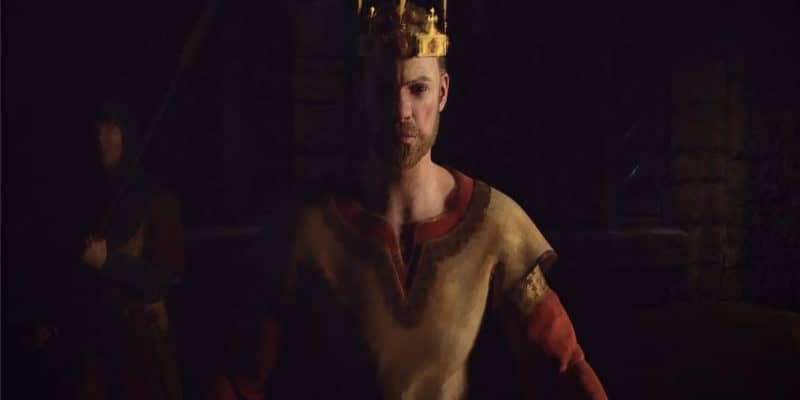
Crusader Kings III, the next installment of Paradox Interactive’s popular grand strategy series, will launch via Steam tomorrow. Set in the Middle Ages, it allows you to revisit history or make it your own. It cleverly does a good job at that, though there are also a few issues.
One thing I can’t fault Paradox, however, is the studio’s decision to include a ginormous world map right from the get-go. The Vanilla Crusader Kings III experience will take you from the cold north of Scotland and the deserts of West Africa to the highlands of Tibet, the mountains of the Himalayas, and the jungles of modern-day Burma.
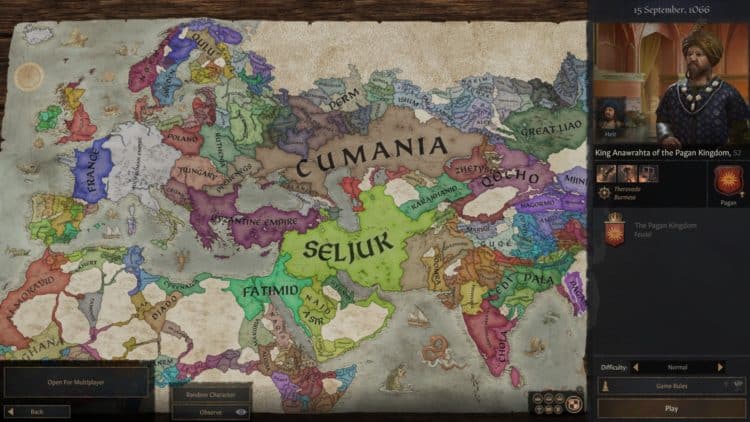
History at your fingertips
If the previous game expanded the map by way of DLCs, then, here, you get all these territories and more. It’s something that series veterans will be overjoyed with. I mean, you get to play as a pagan, or you get to play as Pagan—it’s your call.
Still, the first point of contention is Paradox’s resolution to include only two start dates: 867 AD and 1066 AD. The former is what The Old Gods players would be familiar with, and the latter, of course, is the Norman Invasion start date. Now, you could choose the “interesting” rulers as outlined via Crusader Kings III‘s selection screen, or you could opt to pick an existing leader from these scenarios.
What’s unfortunate about this, due to the sheer lack of other dates, is that you’ll likely never see some historical moments play out. Likewise, you can’t set the dates back and forth per month or year. For instance, if you wanted to start with El Cid as a landed noble or with a resurgent Byzantine Empire outlined in the Alexiad, then you’d need to make the right moves to ensure those moments would come to fruition (if at all). Furthermore, you could forget the notion of Richard the Lionheart battling Saladin in the Holy Land, or any important figure from the east in later years (many personages from the east don’t even show up as “interesting picks” for playthroughs).
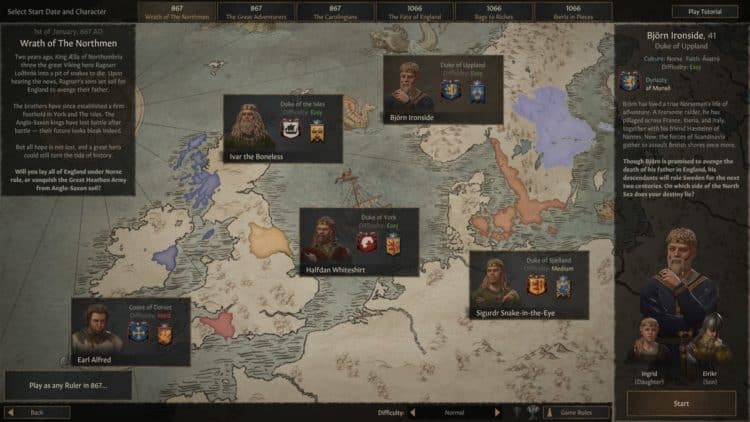
Baby steps with your ruler
Assuming you could get past that qualm, you’ll then choose your ruler. My first playthrough, a 15-hour marathon with Brian II mac Murchad, was part of Crusader Kings III‘s tutorial. I wanted to get a feel of the game in “tutorial island” and see what this “Chad” of Ireland could do. In some ways, it was like riding a bike down a hill with several humps. Crusader Kings III‘s mechanics felt very familiar. On the other hand, however, the UI could be so mind-boggling that even I (a long-time player of Paradox’s offerings) got confused at certain points. I’ll get to those issues in a while.
Anyway, you’ll start by selecting your lifestyle focus which governs your stats, skills, perks, and random events that can trigger related to your character’s growth. Although previously seen in the Way of Life DLC, this feature is given new life in Crusader Kings III. It definitely leans more into the role-playing aspects, and I’m glad that the game embraces that from the beginning.
You’ll then manage the realm starting with your vassals and counties. You’ll construct buildings, raise armies, and wage war. There are several QOL improvements here such as the “Raise All” button and rally point feature that let you spawn your “doomstack.” Your levies, men-at-arms, mercenaries, and holy orders are all recruited and seen via a panel. You don’t need to recruit them per county, and they’re even automatically transported by ships (no need to form a navy). After that, you’ll continue fabricating and pressing claims, selecting lords and ladies to mingle with and marry, all to bring your dynasty to new heights.
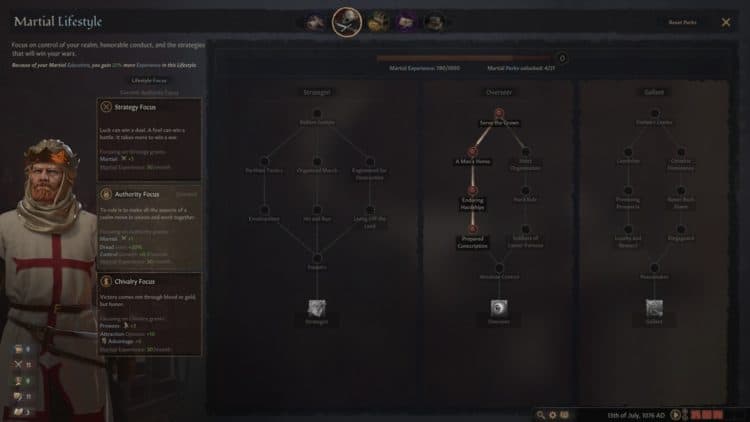
Welcome to my House
While you don’t have a specific goal in Crusader Kings III, the general idea is to extend your dynasty’s reach all over the known world. This is made even more pronounced thanks to stellar new features. For example, dynasties may now have multiple houses/cadet branches. If the founding house dies out, the dynasty lives on thanks to your relatives who managed to make their mark (such as how House Capet of France supplanted the Robertine Dynasty). Dynasty heads may also force other members to stop internecine wars or disinherit a character from the line of succession completely. There are even legacies that you can unlock, powerful boons for the entire dynasty that’d last throughout the campaign.
This is a worthwhile addition and the concept itself is brilliant. You’ve also got decisions that nudge you towards the path of installing kings and queens from your dynasty all over the world or consecrating your bloodline. However, there are also flaws in the execution. Most notably, you could find yourself as the leader with the most titles and the highest rank. But, the game could decide that the house head or dynasty head should be a random duke. It stunts your progress a bit until such time that the leadership passes back to you (it’s quite unclear how this happens).
This issue also comes into play in Crusader Kings III‘s technology system. In the previous game, tech was affected by development and councilor stats. Here, it relies on whoever is the cultural head. Again, there’s a distinct possibility that you might be a king, but a random fella is considered as the cultural head who decides which tech they’re “fascinated” by (aka what’s being researched).
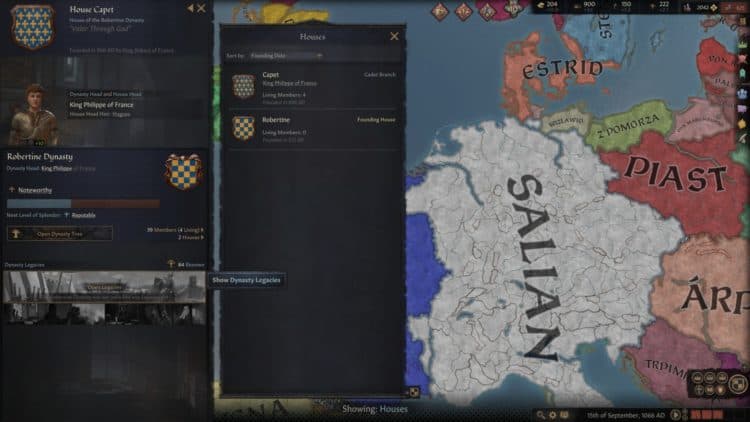
Scheming and plotting
Another major change is how you approach scheming and plotting. Yes, you’ll see some old options such as murder and sway (from Holy Fury), but these are shown on a very clean panel with numerous flavor events presenting distinct choices. There are also “hooks” and “secrets.” As you discover the secrets of another character (such as having a bastard child or committing adultery), you’re able to expose these or turn them into hooks.
The hooks themselves are sort of like favors, in a way. You hold an implicit threat over someone’s head, allowing them to do your bidding such as accepting a change in realm laws, increasing their taxes, forcing an arranged marriage, and so on. You could even choose to ransom or release a prisoner to gain a hook.
I do have a minor gripe since the system can be faulty. For example, “strong hooks” are only earned via blackmail, yet I’ve rarely discovered these. Apparently, letting a captive king leave with his head still on his shoulders just counts as a “weak hook” and that’s that. As for schemes, there is something wrong with the RNG—the “r” in “RNG” becomes too emphasized to the point that having a 95% success rate can lead to abject failure.
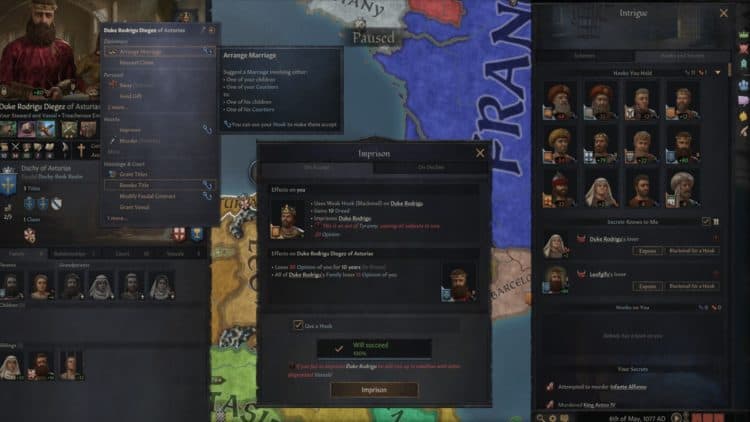
Crusader Kings III‘s borderline confusing UI
Regrettably, Crusader Kings III suffers from a borderline confusing UI, and, in some cases, the advice you seek isn’t properly outlined. Bear in mind that Paradox Interactive’s grand strategy games are already daunting, and there’s a good chance you’ll find yourself clicking multiple portraits and panels just to find what you’re looking for. For example, in the Ireland playthrough, it took me a while to realize that you could switch councilors by clicking on the wheel next to their names as opposed to their portraits. There were also multiple actions that you’d spot if you right-click on a portrait and click on “more,” and those options might pop-up separately (which looks odd).
The system of arranging characters was also a nightmare to get through. There’s a button that lets you sort via stats, a drop-down list for other categories, and even filters. Unfortunately, many characters are listed in a jumbled manner. Imagine playing as an Irish or English king and trying to find a German courtier for your lands in the HRE, only to realize that sorting by culture doesn’t list them alphabetically.
Wars in Crusader Kings III can also be a nuisance due to the “shattered retreat” mechanic—routed armies lead to moments of medieval whack-a-mole. As for revolts, the realm priest’s conversion progress can be so agonizingly slow that it takes decades, not years, to convert one county’s religion. That means there will be one uprising after another that you can’t seem to control. There were even moments when I had to scratch my head, because I was prevented from warring with someone due to a truce. I realized later that the expiration of truces, surprisingly enough, was found on my character’s page—it’s seen by clicking on their portrait and not in the declaration of war (DOW) panel.
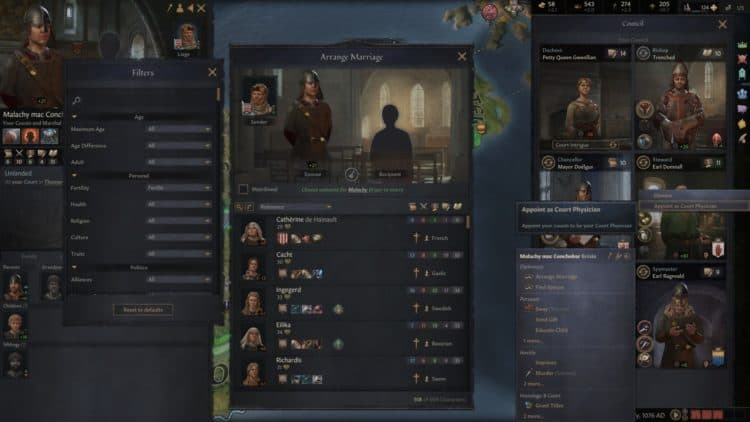
Strange occurrences
In my Ireland campaign, Rome fell to a Muslim ruler in 1085 AD and I was notified that Catholics have access to the crusade mechanic. The diplomatic range prevented me from interacting with the Papal States or with the Muslim sultan of Rome, so I waited for roughly 10 years. Funnily enough, neither the Pope nor any other AI ruler bothered asking Catholics to retake the Eternal City.
Things were quite different in my ironman playthrough as King Sancho II of Castille, though, because Rome never fell. Instead, I was notified about the crusade mechanic in 1123 AD, and then Jerusalem became the target a mere couple of weeks later. It was strange since the game never mentioned the “mean time to happen” (MTTH). In fact, Crusader Kings III‘s helpful encyclopedia of tips doesn’t even have “crusade” as a searchable word; there’s just an entry for “Great Holy Wars” that doesn’t provide you with the details you need.
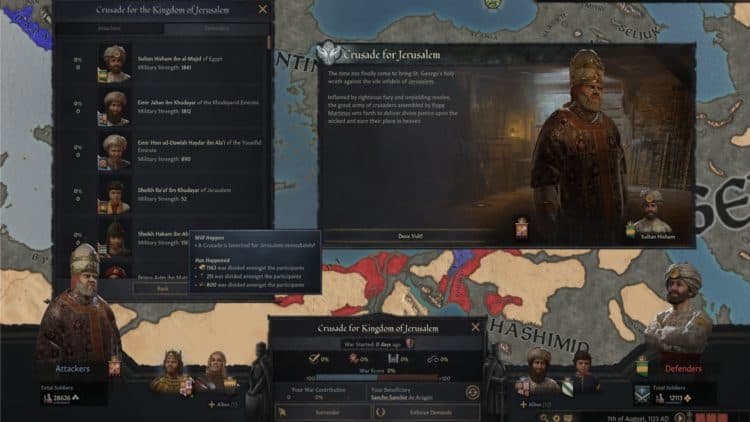
Other strange occurrences I’ve experienced while reviewing Crusader Kings III include my new ruler, a one-year-old Jimena toddler, having his mother (from House Hohenstaufen) for an heir; she wasn’t even descended from any Jimena. It doesn’t look as though there’s a way to assign a regent either, and it’s as if the child was managing the realm.
In another instance, I was unable to ally with my son or offer to join his wars, because he had claims on my titles. I watched as his lands were conquered by a neighbor. I couldn’t even do anything when the big blue blob, France, invaded and killed him during a siege.
Surprisingly, I was able to ally with my daughter to support her reign. Then, she attempted to stab me during a feast, but there was no option to imprison her. When I finally had her jailed (after getting the Pope to excommunicate her), I couldn’t revoke her titles due to our alliance. Defensive pacts and non-aggression pacts don’t seem to be in the game too.

A world for the taking
Crusader Kings III has several shortcomings and issues that are either borderline confusing or downright ridiculous. I’m willing to bet that newcomers will be turned off by UI problems and all the confusion, but a veteran might move past these once they get a hang of things.
Additionally, the flavor events are mostly tied to your lifestyle choices, less so from cultural or faction-based differences. Still, there are some key changes to decisions and core gameplay ideas, such as Tribal governments like the Vikings or nomads being able to raid all and ignore county development often, or the Yapaniya sect of the Rashtrakuta Empire mostly going out in the nude due to their beliefs (with only fig leaves covering their nether regions).
Despite certain similarities, you’ll always follow a personal journey whether you’re a European, African, Arabian, Indian, or nomadic tribesman. I just wish we had a more dynamic and diverse soundtrack. Don’t get me wrong, the music is both beautiful and serene, but it’s the same from Britannia to Cumania.
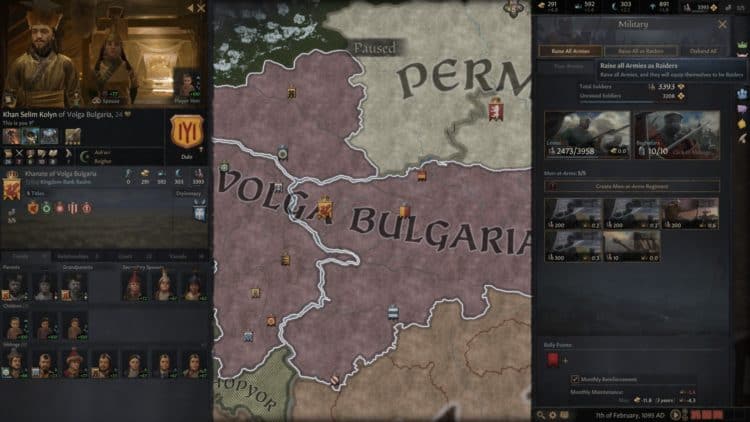
M’lord and m’lady, without the fedora
At the end of it all, Crusader Kings III does manage to surprise and entertain. The critiques I noted were overshadowed by the level of detail and depth you’ll experience. It also helps that the game’s performance is well-optimized. At 4K resolution and the “high” preset, the game continued to run smoothly. There were hardly any major performance drops, and I was getting a stable 60-75 FPS when zoomed in, and 90-100+ FPS when zoomed out (on maximum speed settings, mind you). Other than a few hiccups—such as a couple of crashes after roughly 60 hours of play—Crusader Kings III remained finely tuned. Just try comparing this to Imperator: Rome when it originally released, and it’s like night and day.
Crusader Kings III already has a massive, gorgeous map with countless characters that you can choose from. There are features here that are amazing breaths of fresh air, truly revamping the way you approach this grand strategy offering. The plots/hooks and dynasties/houses would keep you excited for the prospects, even if there were some qualms. You’ll also notice an amalgamation of concepts and mechanics from previous DLCs such as reforming a Pagan faith, and even the means to create your own offshoot religion with its tenets and moral codes.
You’ll grow fond of your nobles now that they feel more alive than ever before. Likewise, you could change their outfits from tunics and armor to cloaks and crowns—there are no fedoras here, thankfully, even if there are “m’ladies.” You watch vividly animated characters (not portraits) grow in strength or from gluttony, succeed or fail in their endeavors, and suffer grievous wounds or recover from them with the scars to prove it. Heck, one of my rulers had a cat that he’d pet to relieve stress (an in-game mechanic). When the cat passed away, I couldn’t help but feel emotional.
I’ve always believed that the Crusader Kings series triumphs when you focus on the role-playing aspects and having a personal journey, and this game is leaps and bounds ahead of others. Like a long-lasting dynasty or empire, Crusader Kings III has very strong foundations; cadet branches—future DLCs—can only help it reach its full potential.
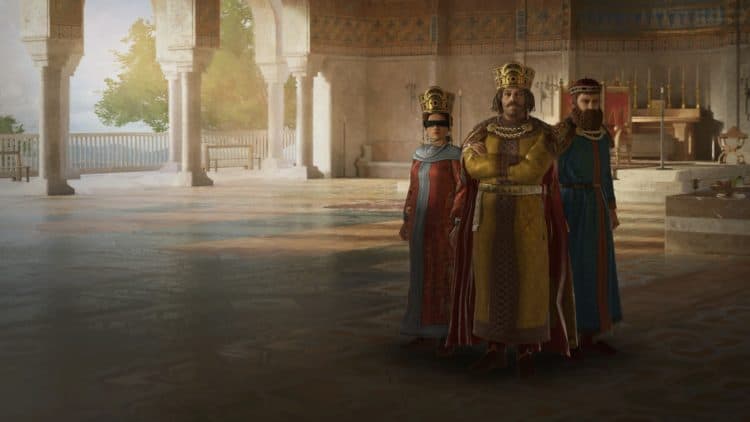
Crusader Kings III
While Crusader Kings III has shortcomings and flaws, these are overshadowed by the sheer number of options and content thanks to its gigantic map and features. Greater emphasis is placed on a character’s or dynasty’s growth, a level of detail not seen in any previous grand strategy title, allowing you to experience trials and tribulations like never before.





More Stories
Firefighting Simulator – The Squad review — Through the fire and the shame
Maid of Sker review — Death in the slow lane
PHOGS! review – It’s a dog-help-dog world out there